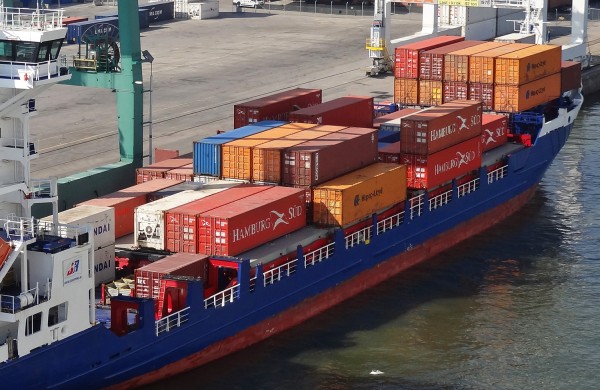 One of President Trump’s main policy slogans has been ‘America first’. As Trump sees it, a manifestation of a country’s economic strength is its current account balance. He would love the USA to have a current account surplus. As it is, it has the largest current account deficit in the world (in absolute terms) of $481 billion in 2016 or 2.6% of GDP. This compares with the UK’s $115bn or 4.4% of GDP. Germany, by contrast, had a surplus in 2016 of $294bn or 8.5% of GDP.
One of President Trump’s main policy slogans has been ‘America first’. As Trump sees it, a manifestation of a country’s economic strength is its current account balance. He would love the USA to have a current account surplus. As it is, it has the largest current account deficit in the world (in absolute terms) of $481 billion in 2016 or 2.6% of GDP. This compares with the UK’s $115bn or 4.4% of GDP. Germany, by contrast, had a surplus in 2016 of $294bn or 8.5% of GDP.
However, he looks at other countries’ current account surpluses suspiciously – they may be a sign, he suspects, of ‘unfair play’. Germany’s surplus of over $50bn with the USA is particularly in his sights. Back in January, as President-elect, he threatened to put a 35% tariff on imports of German cars.
In practice, Germany is governed by eurozone rules, which prevent it from subsidising exports. And it does not have its own currency to manipulate. What is more, it is relatively open to imports from the USA. The EU imposes an average tariff of just 3% on US imports and importers also have to add VAT (19% in the case of Germany) to make them comparably priced with goods produced within the EU.
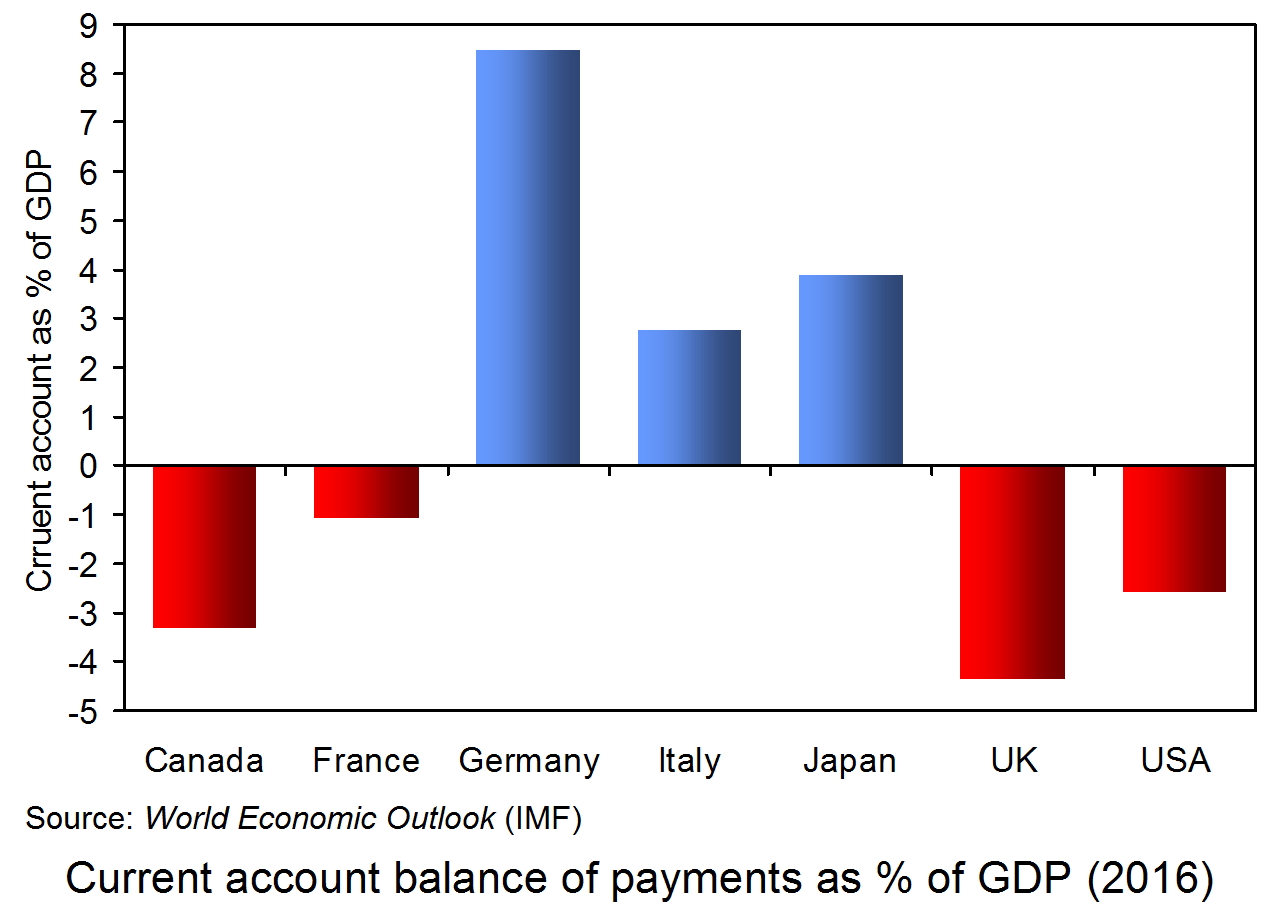 So why does Germany have such a large current account surplus? The article below explores the question and dismisses the claim that it’s the result of currency manipulation or discrimination against imports. The article states that the reason for the German surplus is that:
So why does Germany have such a large current account surplus? The article below explores the question and dismisses the claim that it’s the result of currency manipulation or discrimination against imports. The article states that the reason for the German surplus is that:
… it saves more than it invests. The correspondence of savings minus investment with exports minus imports is not an economic theory; it’s an accounting identity. Germans collectively spend less than they produce, and the difference necessarily shows up as net exports.
But why do the Germans save so much? The answer given is that, with an aging population, Germans are sensibly saving now to support themselves in old age. If Germany were to reduce its current account surplus, this would entail either the government reducing its budget surplus, or people reducing the amount they save, or some combination of the two. This is because a current account surplus, which consists of exports and other incomes from abroad (X) minus imports and any other income flowing abroad (M), must equal the surplus of saving (S) plus taxation (T) over investment (I) plus government expenditure (G). In terms of withdrawals and injections, given that:
I + G + X = S + T + M
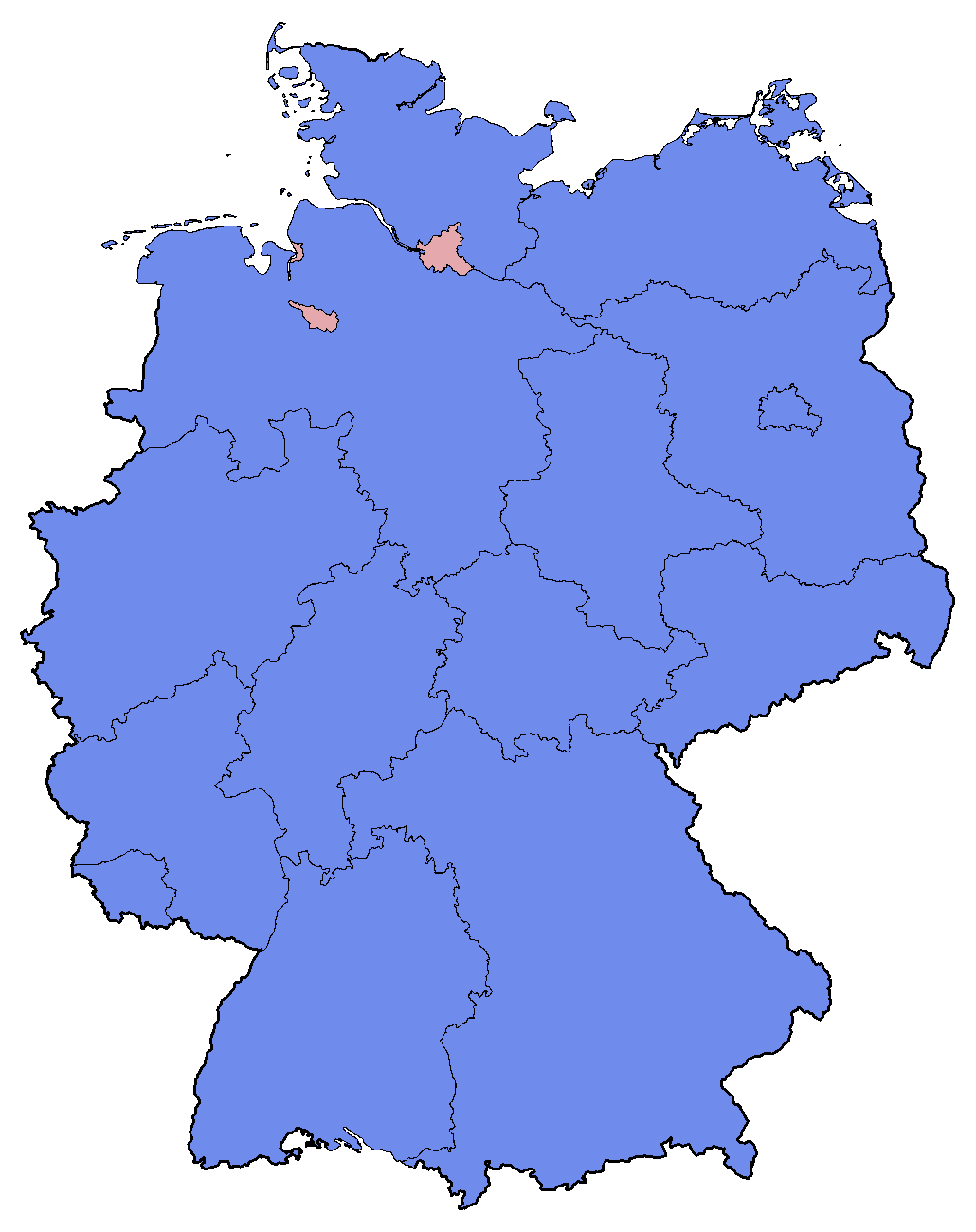 then, rearranging the terms,
then, rearranging the terms,
X – M = (S + T) – (I + G).
If German people are reluctant to reduce the amount they save, then an alternative is for the German government to reduce taxation or increase government expenditure. In the run-up to the forthcoming election on 24 September, Chancellor Merkel’s centre-right CDU party advocates cutting taxes, while the main opposition party, the SPD, advocates increasing government expenditure, especially on infrastructure. The article considers the arguments for these two approaches.
Article
The German economy is unbalanced – but Trump has the wrong answer The Guardian, Barry Eichengreen (12/5/17)
Data
German economic data (in English) Statistisches Bundesamt (Federal Statistical Office)
World Economic Outlook Databases IMF
Questions
- Why does Germany have such a large current account surplus?
- What are the costs and benefits to Germany of having a large current account surplus?
- What is meant by ‘mercantilism’? Why is its justification fallacious?
- If Germany had its own currency, would it be a good idea for it to let that currency appreciate?
- What are meant by ‘resource crowding out’ and ‘financial crowding out’? Why might the policies of tax cuts advocated by the CDU result in crowding out? What form would it take and why?
- Compare the relative benefits of the policies advocated by the CDU and SPD to reduce Germany’s budget surplus.
- Would other countries, such as the USA, benefit from a reduction in Germany’s current account surplus?
- Is what ways would the USA gain and lose from restricting imports from Germany? Would it be a net gain or loss? Explain.
 Theresa May has said that the UK will quit the EU single market and seek to negotiate new trade deals, both with the EU and with other countries. As she said, “What I am proposing cannot mean membership of the single market.” It would also mean leaving the customs union, which sets common external tariffs for goods imported into the EU.
Theresa May has said that the UK will quit the EU single market and seek to negotiate new trade deals, both with the EU and with other countries. As she said, “What I am proposing cannot mean membership of the single market.” It would also mean leaving the customs union, which sets common external tariffs for goods imported into the EU.
The single market guarantees free movement of goods, services, labour and capital between EU members. There are no internal tariffs and common rules and regulations concerning products, production and trade. By leaving the single market, the UK will be able to restrict immigration from EU countries, as it is currently allowed to do from non-EU countries.
A customs union is a free trade area with common external tariffs and uniform methods of handling imports. There are also no, or only minimal, checks and other bureaucracies at borders between members. The EU customs union means that individual EU countries are not permitted to do separate trade deals with non-EU countries.
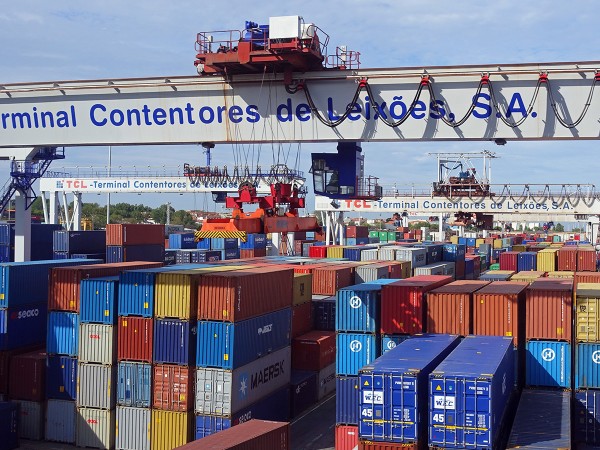 Once the UK has left the EU, probably in around two years’ time, it will then be able to have different trade arrangements from the EU with countries outside the EU. Leaving the customs union would mean that the UK would face the EU’s common external tariff or around 5% on most goods, and 10% on cars.
Once the UK has left the EU, probably in around two years’ time, it will then be able to have different trade arrangements from the EU with countries outside the EU. Leaving the customs union would mean that the UK would face the EU’s common external tariff or around 5% on most goods, and 10% on cars.
Leaving the EU single market and customs union has been dubbed ‘hard Brexit’. Most businesses and many politicians had hoped that elements of the single market could be retained, such as tariff-free trade between the UK and the EU and free movement of capital. However, by leaving the single market, access to it will depend on the outcome of negotiations.
Negotiations will take place once Article 50 – the formal notice of leaving – has been invoked. The government has said that it will do this by the end of March this year. Then, under EU legislation, there will be up to two years of negotiations, at which point the UK will leave the EU.
The articles look at the nature of the EU single market and customs union and at the implications for the UK of leaving them.
Articles
Britain to leave EU market as May sets ‘hard Brexit’ course Reuters, Kylie MacLellan and William James (17/1/17)
Brexit: UK to leave single market, says Theresa May BBC News (17/1/17)
How Does U.K. Want to Trade With EU Post-Brexit?: QuickTake Q&A Bloomberg, Simon Kennedy (17/1/17)
Brexit at-a-glance: What we learned from Theresa May BBC News, Tom Moseley (17/1/17)
Theresa May unveils plan to quit EU single market under Brexit Financial Times, Henry Mance (17/1/17)
Doing Brexit the hard way The Economist (21/1/17)
Theresa May confirms it’ll be a hard Brexit – here’s what that means for trade The Conversation, Billy Melo Araujo (17/1/17)
How to read Theresa May’s Brexit speech The Conversation, Paul James Cardwell (17/1/17)
Theresa May’s hard Brexit hinges on a dated vision of global trade The Conversation, Martin Smith (17/1/17)
Brexit: What is the EU customs union and why should people care that the UK is leaving it? Independent, Ben Chapman (17/1/17)
Questions
- Explain the difference between a free-trade area, a customs union, a common market and a single market.
- What arrangement does Norway have with the EU?
- How would the UK’s future relationship with the EU differ from Norway’s?
- Distinguish between trade creation and trade diversion from joining a customs union. Who loses from trade diversion?
- Will leaving the EU mean that trade which was diverted can be reversed?
- What will determine the net benefits from new trade arrangements compared with the current situation of membership of the EU?
- What are the possible implications of hard Brexit for (a) inward investment and (b) companies currently in the UK of relocating to other parts of the EU? Why is the magnitude of such effects extremely hard to predict?
- Explain what is meant by ‘passporting rights’ for financial services firms. Why are they unlikely still to have such rights after Brexit?
- Discuss the argument put forward in The Conversation article that ‘Theresa May’s hard Brexit hinges on a dated vision of global trade’.
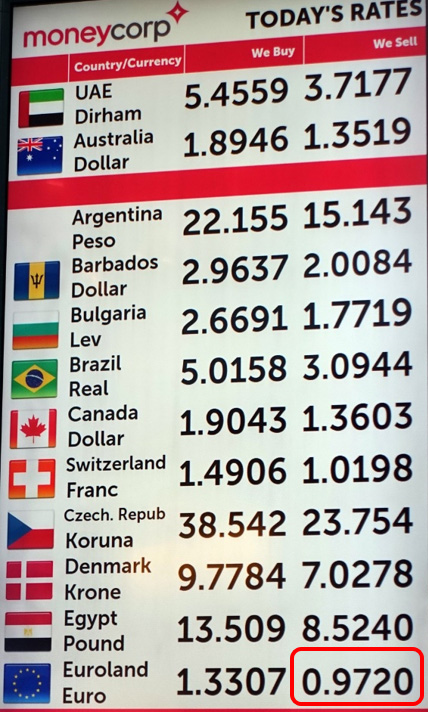
The pound has fallen to its lowest rate against the euro since July 2013 and the lowest rate against the US dollar since 1985. Since August 2015, the pound has depreciated by 23.4% against the euro and 22.2% against the dollar. And since the referendum of 23 June, it has depreciated by 15.6% against the euro and 17.6% against the dollar.
On Sunday 2 October, at the start of the Conservative Party conference, the Prime Minister announced that Article 50, which triggers the Brexit process, would be invoked by the end of March 2017. Worries about what the terms of Brexit would look like put further pressure on the pound: the next day it fell by around 1% and the next day by a further 0.5%.
Then, on 6 October, it was reported that President Hollande was demanding tough Brexit negotiations and the pound dropped significantly further. By 7 October, it was trading at around €1.10 and $1.22. At airports, currency exchange agencies were offering less than €1 per £ (see picture).
With the government implying that Brexit might involve leaving the Single Market, the pound continued falling. On 12 October, the trade-weighted index reached its lowest level since the index was introduced in 1980: below its trough in the depth of the 2008 financial crisis and below the 1993 trough following Britain’s ejection from the European Exchange Rate Mechanism in September 1992.
So just why has the pound fallen so much, both before and after the Brexit vote? (Click here for a PowerPoint of the chart.) And what are the implications for the economy?
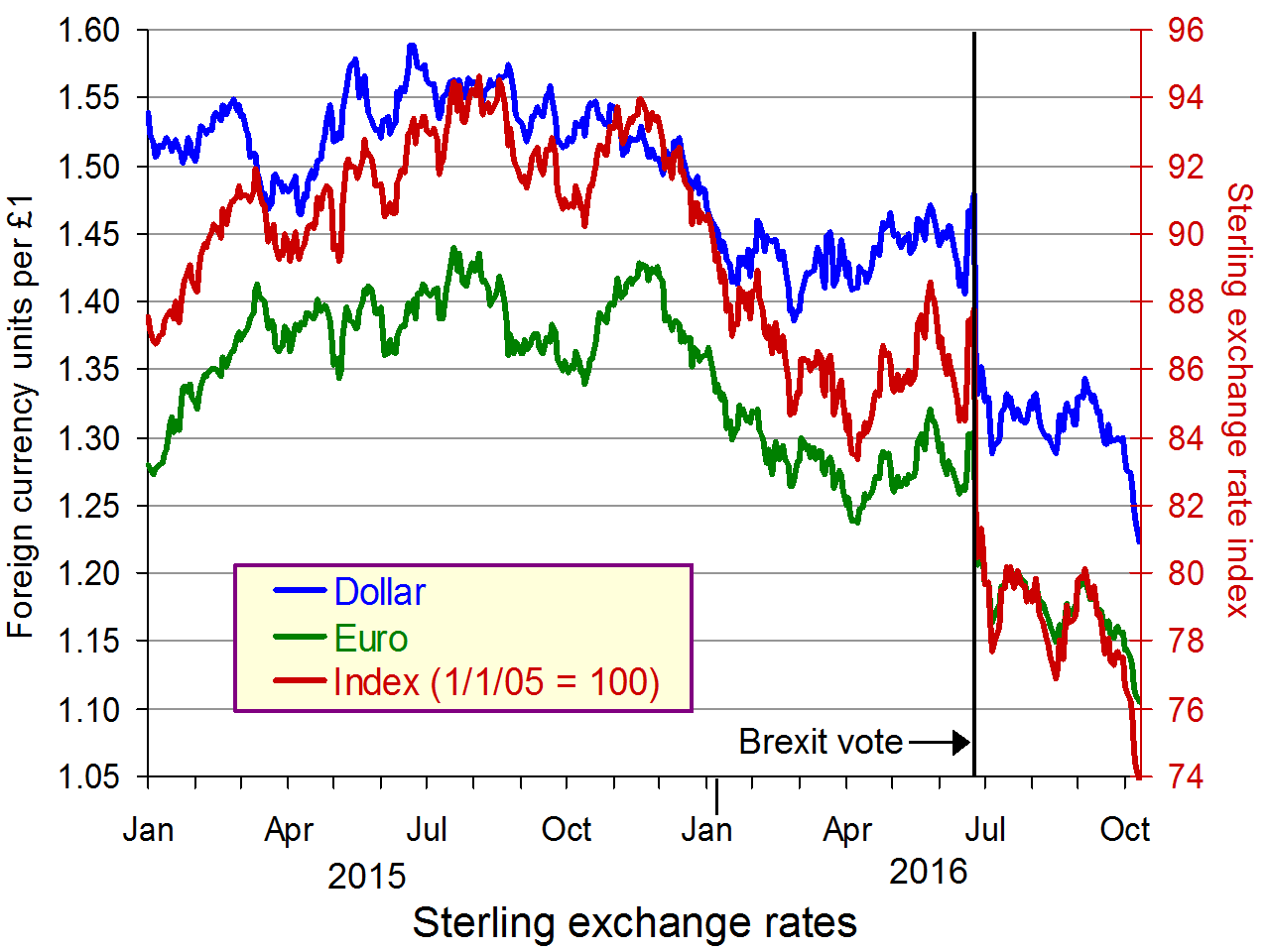 The articles explore the reasons for the depreciation. Central to these are the effects on the balance of payments from a possible decline in inward investment, lower interest rates leading to a net outflow of currency on the financial account, and stimulus measures, both fiscal and monetary, leading to higher imports.
The articles explore the reasons for the depreciation. Central to these are the effects on the balance of payments from a possible decline in inward investment, lower interest rates leading to a net outflow of currency on the financial account, and stimulus measures, both fiscal and monetary, leading to higher imports.
Worries about the economy were occurring before the Brexit vote and this helped to push sterling down in late 2015 and early 2016, as you can see in the chart. This article from The Telegraph of 14 June 2016 explains why.
Despite the short-run effects on the UK economy of the Brexit vote not being as bad as some had predicted, worries remain about the longer-term effects. And these worries are compounded by uncertainty over the Brexit terms.
A lower sterling exchange rate reduces the foreign currency price of UK exports and increases the sterling price of imports. Depending on price elasticities of demand, this should improve the current account of the balance of payments.
These trade effects will help to boost the economy and go some way to countering the fall in investment as businesses, uncertain over the terms of Brexit, hold back on investment in the UK.
Articles
 Pound Nears Three-Decade Low as May Sets Date for Brexit Trigger Bloomberg, Netty Idayu Ismail and Charlotte Ryan (3/10/16)
Pound Nears Three-Decade Low as May Sets Date for Brexit Trigger Bloomberg, Netty Idayu Ismail and Charlotte Ryan (3/10/16)
Sterling near 31-year low against dollar as May sets Brexit start dat Financial Times, Michael Hunter and Roger Blitz (3/10/16)
Sterling hits three-year low against the euro over Brexit worries The Guardian, Katie Allen (3/10/16)
Pound sterling value drops as Theresa May signals ‘hard Brexit’ at Tory conference Independent, Zlata Rodionova (3/10/16)
Pound falls as Theresa May indicates Brexit date BBC News (3/10/16)
The pound bombs and stocks explode over fears of a ‘hard Brexit’ Business Insider UK, Oscar Williams-Grut (3/10/16)
Pound Will Feel Pain as Brexit Clock Ticks Faster Wall Street Journal, Richard Barley (3/10/16)
British Pound to Euro Exchange Rate’s Brexit Breakdown Slows After Positive Manufacturing PMI Halts Decline Currency Watch, Joaquin Monfort (3/10/16)
7 ways the fall in the value of the pound affects us all Independent (4/10/16)
The pound and the fury: Brexit is making Britons poorer, and meaner The Economist, ‘Timekeeper’ (11/10/16)
Is the pound headed for parity v US dollar and euro? Sydney Morning Herald, Jessica Sier (5/10/16)
Flash crash sees the pound gyrate in Asian trading BBC News (7/10/16)
Flash crash hits pound after Hollande remarks Deutsche Welle (7/10/16)
Sterling mayhem gives glimpse into future Reuters, Swaha Pattanaik (7/10/16)
Sterling takes a pounding The Economist, Buttonwood (7/10/16)
Government must commit to fundamental reform The Telegraph, Andrew Sentance (7/10/16)
Data
Interest & exchange rates data – Statistical Interactive Database Bank of England
Questions
- Why has sterling depreciated? Use a demand and supply diagram to illustrate your argument.
- What has determined the size of this depreciation?
- What is meant by the risk premium of holding sterling?
- To what extent has the weaker pound contributed to the better economic performance than was expected immediately after the Brexit vote?
- What factors will determine the value of sterling over the coming months?
- Who gain and who lose from a lower exchange rate?
- What is likely to happen to inflation over the coming months? Explain and consider the implications for monetary and fiscal policy.
- What is a ‘flash crash’. Why was there a flash crash in sterling on Asian markets on 7 October 2016? Is such a flash crash in sterling likely to occur again?
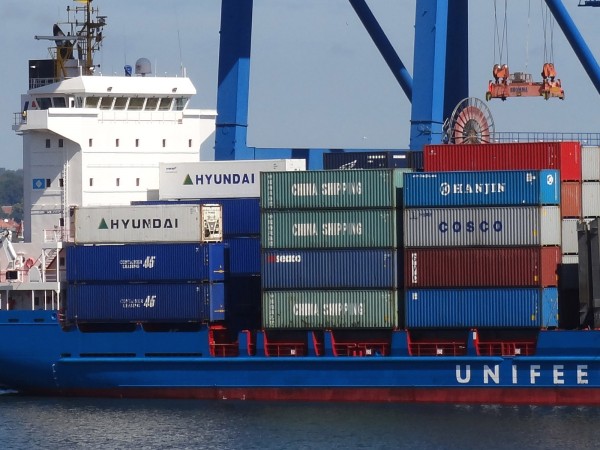 In a recent blog, Falling sterling – bad for some; good for others, we looked at the depreciation of sterling following the Brexit vote. We saw how it will have beneficial effects for some, such as exporters, and adverse effects for others, such as consumers having to pay a higher price for imports and foreign holidays. The article linked below examines these effects in more depth.
In a recent blog, Falling sterling – bad for some; good for others, we looked at the depreciation of sterling following the Brexit vote. We saw how it will have beneficial effects for some, such as exporters, and adverse effects for others, such as consumers having to pay a higher price for imports and foreign holidays. The article linked below examines these effects in more depth.
Just how much the quantity of exports will increase depends on two main things. The first is the amount by which the foreign currency price falls. This depends on what exporters choose to do. Say the pound falls from €1.30 to €1.18. Do exporters who had previously sold a product selling in the UK for £100 and in the eurozone for €130, now reduce the euro price to €118? Or do they put it down by less – say, to €125, thereby earning £105.93 (£(125/1.18)). Their sales would increase by less, but their profit margin would rise.
The second is the foreign currency price elasticity of demand for exports in the foreign markets. The more elastic it is, the more exports will rise for any given euro price reduction.
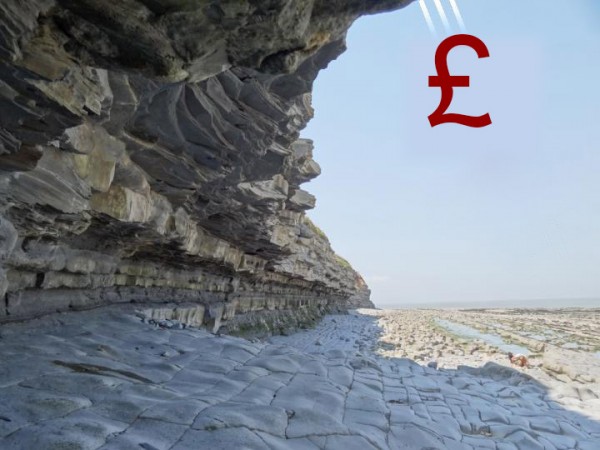 It is similar with imports. How much the sales of these fall depends again on two main things. The first is the amount by which the importing companies are prepared to raise sterling prices. Again assume that the pound falls from €1.30 to €1.18 – in other words, the euro rises from 76.92p (£1/1.3) to 84.75p (£1/1.18). What happens to the price of an import to the UK from the eurozone whose euro price is €100? Does the importer raise the price from £76.92 to £84.75, or by less than that, being prepared to accept a smaller profit margin?
It is similar with imports. How much the sales of these fall depends again on two main things. The first is the amount by which the importing companies are prepared to raise sterling prices. Again assume that the pound falls from €1.30 to €1.18 – in other words, the euro rises from 76.92p (£1/1.3) to 84.75p (£1/1.18). What happens to the price of an import to the UK from the eurozone whose euro price is €100? Does the importer raise the price from £76.92 to £84.75, or by less than that, being prepared to accept a smaller profit margin?
The second is the sterling price elasticity of demand for imports in the UK. The more elastic it is, the more imports will fall and, probably, the more the importer will be prepared to limit the sterling price increase.
The article also looks at the effect on aggregate demand. As we saw in the previous blog, a depreciation boosts aggregate demand by increasing exports and curbing imports. The effects of this rise in aggregate demand depends on the degree of slack in the economy and the extent, therefore, that (a) exporters and those producing import substitutes can respond in terms of high production and employment and (b) other sectors can produce more as multiplier effects play out.
Finally, the article looks at the effect of the depreciation of sterling on asset prices. UK assets will be worth less in foreign currency terms; foreign assets will be worth more in sterling. Just how much the prices of internationally traded assets, such as shares and some property, will change depends, again, on their price elasticities of demand. In terms of assets, there has been a gain to UK balance sheets from the depreciation. As Roger Bootle says:
Whereas the overwhelming majority of the UK’s liabilities to foreigners are denominated in sterling, the overwhelming bulk of our assets abroad are denominated in foreign currency. So the lower pound has raised the sterling value of our overseas assets while leaving the sterling value of our liabilities more or less unchanged.
Article
How a lower pound will help us to escape cloud cuckoo land, The Telegraph, Roger Bootle (31/7/16)
Questions
- What determines the amount that exporters from the UK adjust the foreign currency price of their exports following a depreciation of sterling?
- What determines the amount by which importers to the UK adjust the sterling price of their products following a depreciation of sterling?
- What determines the amount by which sterling will depreciate over the coming months?
- Distinguish between stabilising and destabilising speculation? How does this apply to exchange rates and what determines the likelihood of there being destabilising speculation against sterling exchange rates?
- How is UK inflation likely to be affected by a depreciation of sterling?
- Why does Roger Bootle believe that the UK has been living in ‘cloud cuckoo land’ with respect to exchange rates?
- Why has the UK managed to sustain a large current account deficit over so many years?
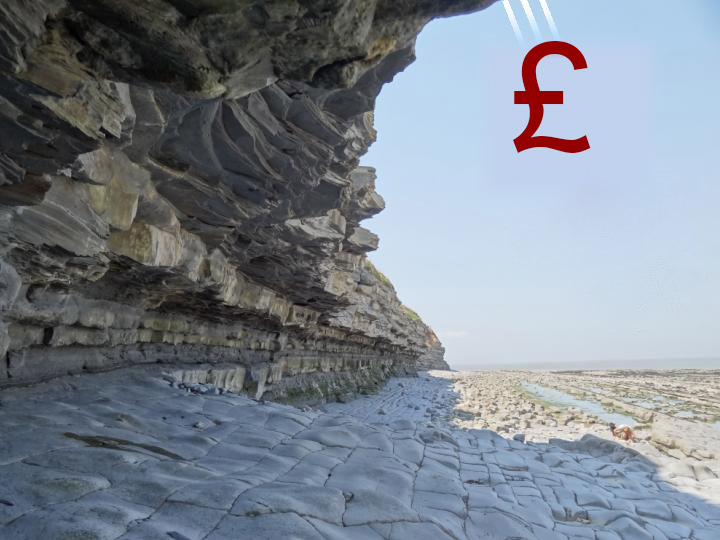 Since the Brexit vote in the referendum, sterling has been falling. It is now at a 31-year low against the US dollar. From 23 June to 6 July it depreciated by 12.9% against the US dollar, 10.7% against the euro and 17.0% against the yen. The trade-weighted sterling exchange rate index depreciated by 11.6%.
Since the Brexit vote in the referendum, sterling has been falling. It is now at a 31-year low against the US dollar. From 23 June to 6 July it depreciated by 12.9% against the US dollar, 10.7% against the euro and 17.0% against the yen. The trade-weighted sterling exchange rate index depreciated by 11.6%.
Why has this happened? Partly it reflects a decline in confidence in the UK economy by investors; partly it is in response to policy measures, actual and anticipated, by the Bank of England.
As far as investors are concerned, the anticipation is that there will be net direct investment outflows from the UK. This is because some companies in the UK are considering relocating part or all of their business from the UK to elsewhere in Europe. For example, EasyJet is drawing up plans to move its headquarters to continental Europe. It is also because investors believe that foreign direct investment in the UK is likely to fall as companies prefer to invest elsewhere, such as Ireland or Germany.
 Thus although the effect of net direct investment outflows (or reductions in net inflows) will be on the long-term investment part of the financial account of the balance of payments, the immediate effect is felt on the short-term financial flows part of the account as investors anticipate such moves and the consequent fall in sterling.
Thus although the effect of net direct investment outflows (or reductions in net inflows) will be on the long-term investment part of the financial account of the balance of payments, the immediate effect is felt on the short-term financial flows part of the account as investors anticipate such moves and the consequent fall in sterling.
As far as monetary policy is concerned, the fall in sterling is in response to four things announced or signalled by Mark Carney at recent news conferences (see Monetary and fiscal policies – a U-turn or keeping the economy on track?).
First is the anticipated fall in Bank Rate at the next meeting of the Monetary Policy Committee on 13/14 July. Second is the possibility of further quantitative easing (QE). Third is an additional £250bn of liquidity that the Bank is prepared to provide through its normal open-market operations. Fourth is the easing of capital requirements on banks (reducing the countercyclical buffer from 0.5% to 0%), which would allow additional lending by banks of up to £150bn.
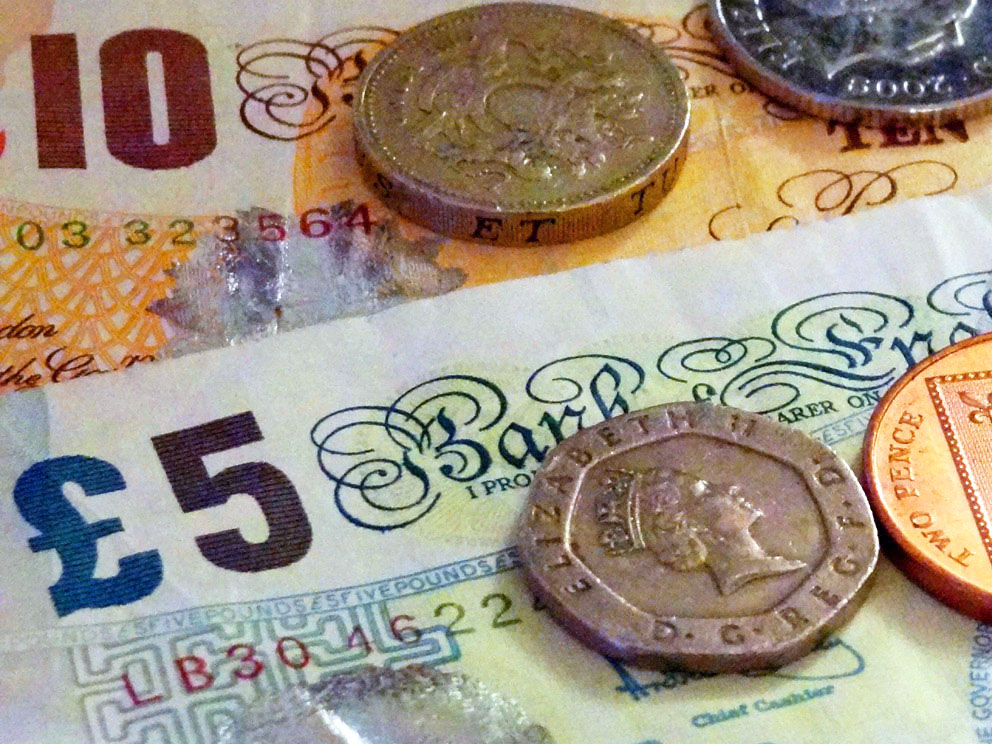 Lower interest rates, additional liquidity and further QE would all increase the supply of sterling on the foreign exchange markets. The anticipation of this, plus the anticipation of lower interest rates, would decrease the demand for sterling. The effect of these supply and demand changes is a fall in the exchange rate.
Lower interest rates, additional liquidity and further QE would all increase the supply of sterling on the foreign exchange markets. The anticipation of this, plus the anticipation of lower interest rates, would decrease the demand for sterling. The effect of these supply and demand changes is a fall in the exchange rate.
But is a fall in the exchange rate a ‘good thing’? As far as consumers are concerned, the answer is no. Imports will be more expensive, as will foreign holidays. People’s pounds will buy less of things priced in foreign currency and thus people will be poorer.
As far as exporters are concerned, however, the foreign currency they earn will exchange into more pounds than before. Their sterling revenues, therefore, are likely to increase. They might also choose to reduce the foreign currency price of exports, thereby increasing the quantity sold – the amount depending on the price elasticity of demand. The increase in exports and reduction in imports will help to reduce the current account deficit and also boost aggregate demand.
Articles
Pound slumps to 31-year low following Brexit vote The Guardian, Katie Allen , Jill Treanor and Simon Goodley (24/6/16)
Sterling’s post-Brexit fall is biggest loss in a hard currency Reuters, Jamie McGeever (7/7/16)
Brexit Accelerates the British Pound’s 100 Years of Debasement Bloomberg, Simon Kennedy and Lukanyo Mnyanda (5/7/16)
Pound sterling falls below $1.31 hitting new 31-year low Independent, Hazel Sheffield (5/7/16)
Viewpoints: How low will sterling go? BBC News, Leisha Chi (6/7/16)
How low will the pound fall? Financial Times (7/7/16)
Allianz’s El-Erian says UK must urgently get its act together or dollar parity could beckon Reuters, Guy Faulconbridge (7/7/16)
What does a falling pound mean for the British economy? The Telegraph, Peter Spence (6/7/16)
Data
Spot exchange rates: Statistical Interactive Database – interest & exchange rates data Bank of England
Questions
- What determines how much the exchange rate depreciates for a given shift in the demand for sterling or the supply of sterling?
- Why might the short-term effects on exchange rates of the Brexit vote be different from the long-term effects?
- Why has the pound depreciated by different amounts against different currencies?
- What are likely to be the effects on the financial and current accounts of the balance of payments of the Bank of England’s measures?
- Find out what has happened to business confidence since the Brexit vote. What effect does the level of confidence have on the exchange rate and why?
 One of President Trump’s main policy slogans has been ‘America first’. As Trump sees it, a manifestation of a country’s economic strength is its current account balance. He would love the USA to have a current account surplus. As it is, it has the largest current account deficit in the world (in absolute terms) of $481 billion in 2016 or 2.6% of GDP. This compares with the UK’s $115bn or 4.4% of GDP. Germany, by contrast, had a surplus in 2016 of $294bn or 8.5% of GDP.
One of President Trump’s main policy slogans has been ‘America first’. As Trump sees it, a manifestation of a country’s economic strength is its current account balance. He would love the USA to have a current account surplus. As it is, it has the largest current account deficit in the world (in absolute terms) of $481 billion in 2016 or 2.6% of GDP. This compares with the UK’s $115bn or 4.4% of GDP. Germany, by contrast, had a surplus in 2016 of $294bn or 8.5% of GDP. So why does Germany have such a large current account surplus? The article below explores the question and dismisses the claim that it’s the result of currency manipulation or discrimination against imports. The article states that the reason for the German surplus is that:
So why does Germany have such a large current account surplus? The article below explores the question and dismisses the claim that it’s the result of currency manipulation or discrimination against imports. The article states that the reason for the German surplus is that:









